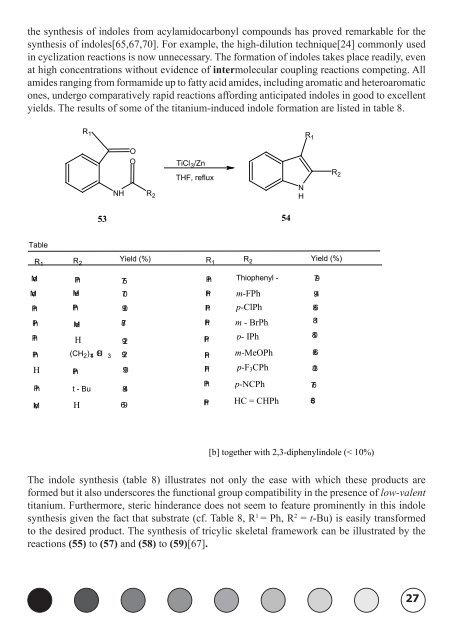Low-Valent Titanium Induced Carbonyl Coupling Reactions
Low-Valent Titanium Induced Carbonyl Coupling Reactions
Low-Valent Titanium Induced Carbonyl Coupling Reactions
You also want an ePaper? Increase the reach of your titles
YUMPU automatically turns print PDFs into web optimized ePapers that Google loves.
the synthesis of indoles from acylamidocarbonyl compounds has proved remarkable for the<br />
synthesis of indoles[65,67,70]. For example, the high-dilution technique[24] commonly used<br />
in cyclization reactions is now unnecessary. The formation of indoles takes place readily, even<br />
at high concentrations without evidence of intermolecular coupling reactions competing. All<br />
amides ranging from formamide up to fatty acid amides, including aromatic and heteroaromatic<br />
ones, undergo comparatively rapid reactions affording anticipated indoles in good to excellent<br />
yields. The results of some of the titanium-induced indole formation are listed in table 8.<br />
Table<br />
R 1<br />
53<br />
O<br />
O<br />
NH R 2<br />
TiCl 3/Zn<br />
THF, reflux<br />
R1 R Yield (%)<br />
2 R1 R2 Yield (%)<br />
Me Ph<br />
Me Me<br />
Ph<br />
Ph<br />
Ph Me<br />
Ph<br />
Ph<br />
H<br />
(CH 2) 14 CH 3<br />
Ph<br />
Ph t - Bu<br />
Me H<br />
75<br />
70<br />
90<br />
87<br />
H 92<br />
92<br />
90<br />
84<br />
69<br />
Ph<br />
Thiophenyl -<br />
Ph m-FPh<br />
Ph p-ClPh<br />
Ph m - BrPh<br />
Ph<br />
Ph<br />
Ph<br />
Ph<br />
Ph<br />
p- IPh<br />
m-MeOPh<br />
p-F3CPh<br />
p-NCPh<br />
HC = CHPh<br />
54<br />
N<br />
H<br />
R 1<br />
79<br />
94<br />
86<br />
81<br />
80<br />
86<br />
83<br />
76<br />
68<br />
R 2<br />
[b] together with 2,3-diphenylindole (< 10%)<br />
The indole synthesis (table 8) illustrates not only the ease with which these products are<br />
formed but it also underscores the functional group compatibility in the presence of low-valent<br />
titanium. Furthermore, steric hinderance does not seem to feature prominently in this indole<br />
synthesis given the fact that substrate (cf. Table 8, R 1 = Ph, R 2 = t-Bu) is easily transformed<br />
to the desired product. The synthesis of tricylic skeletal framework can be illustrated by the<br />
reactions (55) to (57) and (58) to (59)[67].<br />
27










